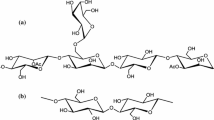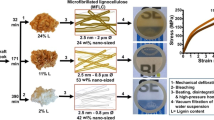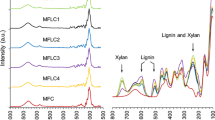Abstract
The interactions with water and the physical properties of microfibrillated celluloses (MFCs) and associated films generated from wood pulps of different yields (containing extractives, lignin, and hemicelluloses) have been investigated. MFCs were produced by combining mechanical refining and a high pressure treatment using a homogenizer. The produced MFCs were characterized by morphology analysis, water retention, hard-to-remove water content, and specific surface area. Regardless of chemical composition, processing to convert macrofibrils to microfibrils resulted in a decrease in water adsorption and water vapor transmission rate, both important properties for food packaging applications. After homogenization, MFCs with high lignin content had a higher water vapor transmission rate, even with a higher initial contact angle, hypothesized to be due to large hydrophobic pores in the film. A small amount of paraffin wax, less than 10%, reduced the WVTR to a similar value as low density polyethylene. Hard-to-remove water content correlated with specific surface area up to approximately 50 m2/g, but not with water retention value. The drying rate of the MFCs increased with the specific surface area. Hornified fibers from recycled paper also have the potential to be used as starting materials for MFC production as the physical and optical properties of the films were similar to the films from virgin fibers. In summary, the utilization of lignin containing MFCs resulted in unique properties and should reduce MFC production costs by reducing wood, chemical, and energy requirements.








Similar content being viewed by others
References
de Vlieger J (2003) Green plastics for food packaging. In: Ahvenainen R (ed) Novel food packaging techniques. New York, CRC Press LLC
Erkisen O, Syverud K, Gregersen O (2008) The use of microfibrillated cellulose produced from kraft pulp as strength enhancer in TMP paper. Nord Pulp Paper Res J 23:299–304
Fukuzumi H, Saito T, Iwata T, Kumamoto Y, Isogai A (2009) Transparent and high gas barrier films of cellulose nanofibers prepared by TEMPO-mediated oxidation. Biomacromolecules 10:162–165
Goodrich J, Winter W (2007) α-Chitin nanocrystals prepared from shrimp shells and their specific surface area measurement. Biomacromolecules 8:252–257
Haslach H (2000) The moisture and rate-dependent mechanical properties of paper: a review. Mech Time-Depend Mater 4:169–210
Henriksson M, Henriksson G, Berglund L, Lindstrom T (2007) An environmentally friendly method for enzyme-assisted preparation of microfibrillated cellulose (MFC) nanofibers. Eur Polym J 43:3434–3441
Henriksson M, Berglund L, Isaksson P, Lindstrom T, Nishino N (2008) Cellulose nanopaper structures of high toughness. Biomacromolecules 9:1579–1585
Hu Y, Topolkaraev V, Hiltner A, Baer E (2000) Measurement of water vapor transmission rate in highly permeable films. J Appl Polym Sci 81:1624–1633
Kirwan M (2003) Paper and paperboard packaging. In: Coles R, McDowell D, Kirwan MJ (eds) Food packaging technology. CRC Press LLC, Boca Raton, pp 241–281
Kirwan M, Strawbridge J (2003) Plastics in food packaging. In: Coles R, McDowell D, Kirwan MJ (eds) Food packaging technology. CRC Press LLC, Boca Raton, pp 174–240
Ougiya H, Hioki N, Watanabe K, Morinaga Y, Yoshinaga F, Samejima M (1998) Relationship between the physical properties and surface area of cellulose derived from adsorbates of various molecular sizes. Biosci Biotechnol Biochem 62:1880–1884
Park S, Venditti R, Jameel H, Pawlak J (2006a) Hard to remove water in cellulose fibers characterized by high resolution thermogravimetric analysis - methods development. Cellulose 13:23–30
Park S, Venditti R, Jameel H, Pawlak J (2006b) A novel method to evaluate fiber hornification by high resolution thermogravimetric analysis. Appita J 59:481–485
Rhim J (2007) Potential use of biopolymer-based nanocomposite films in food packaging applications. Food Sci Biotechnol 16:691–709
Rhim J, NG P (2007) Natural biopolymer-based nanocomposite films for packaging applications. Crit Rev Food Sci Nutr 47:411–433
Saito T, Isogai A (2004) TEMPO-mediated oxidation of native cellulose. The effect of oxidation conditions on chemical and crystal structures of the water-insoluble fractions. Biomacromolecules 5:1983–1989
Spence K, Venditti R, Habibi Y, Rojas O, Pawlak J (2010) The effect of chemical composition on microfibrillar cellulose films from wood pulps: mechanical processing and physical properties. Bioresour Technol 101:5961–5968
Syverud K, Stenius P (2009) Strength and barrier properties of MFC films. Cellulose 16:75–85
T204 (1997) Solvent extractives of wood and pulp. 2000–2001 TAPPI Test Methods, TAPPI
T222 (1998) Acid-insoluble lignin in wood and pulp. 2000–2001 TAPPI Test Methods, TAPPI
T227 (1999) Freeness of pulp (Canadian standard method). 2000–2001 TAPPI Test Methods, TAPPI
T249 (2000) Carbohydrate composition of extractive-free wood and wood pulp by gas–liquid chromatography. 2000–2001 TAPPI Test Methods, TAPPI
T252 (1998) pH and electrical conductivity of hot water extracts of pulp, paper, and paperboard. 2000–2001 TAPPI Test Methods, TAPPI
T404 (1992) Tensile breaking strength and elongation of paper and paperboard (using pendulum-type tester). 2000–2001 TAPPI Test Methods, TAPPI
T410 (1998) Grammage of paper and paperboard (weight per unit area). 2000–2001 TAPPI Test Methods, TAPPI
T411 (1997) Thickness (caliper) of paper, paperboard, and combined board. 2000–2001 TAPPI Test Methods, TAPPI
T452 (1998) Brightness of pulp, paper, and paperboard (directional reflectance at 457 nm). 2000–2001 TAPPI Test Methods, TAPPI
T519 (1996) Diffuse opacity of paper (d/0o paper backing). 2000–2001 TAPPI Test Methods, TAPPI
T527 (1994) Color of paper and paperboard (d/0o geometry). 2000 - 2001 TAPPI Test Methods, TAPPI
T555 (1999) Roughness of paper and paperboard (print-surf method). 2000–2001 TAPPI Test Methods, TAPPI
Tamai Y, Aratani (1972) Experimental study of the relation between contact angle and surface roughness. J Phys Chem 76:3267–3271
Turbak A, Snyder F, Sandberg K (1983) Microfibrillated cellulose: a new cellulose product: properties, uses, and commercial potential. J Appl Polym Sci Appl Polym Symp 37:815–827
UM256 (1981) Water retention value (WRV). TAPPI useful test methods, TAPPI
Welf E, Venditti R, Hubbe M (2005) The effects of heating without water removal and drying on the swelling as measured by water retention value and degradation as measured by intrinsic viscosity of cellulose papermaking fibers. Prog Pap Recycl 14:5–13
Yano H, Nakahara S (2008) High strength material using cellulose microfibrils. U.S. Patent 7,378,149
Zhang M, Hubbe M, Venditti R, Heitmann J (2004) Effects of sugar addition before drying on the wet-flexibility of redispersed kraft fibers. J Pulp Pap Sci 30:29–34
Acknowledgments
This project was supported by the USDA/CSREES Higher Education Food and Agricultural Sciences National Needs Graduate and Post-Graduate Fellowship Grants program, grant number 2007-38420-17772. We would like to acknowledge Kevin Daniel for assistance in film testing and Linda McMurray, Ricardo Santos, and Ewellyn Capanema for assistance in pulp chemical composition analysis. Furthermore, the assistance of Dr. Jung Myoung Lee, Rachel Ernest, and Andy Cibils in the development of the film forming and pretreatment technique is appreciated.
Author information
Authors and Affiliations
Corresponding author
Rights and permissions
About this article
Cite this article
Spence, K.L., Venditti, R.A., Rojas, O.J. et al. The effect of chemical composition on microfibrillar cellulose films from wood pulps: water interactions and physical properties for packaging applications. Cellulose 17, 835–848 (2010). https://doi.org/10.1007/s10570-010-9424-8
Received:
Accepted:
Published:
Issue Date:
DOI: https://doi.org/10.1007/s10570-010-9424-8




